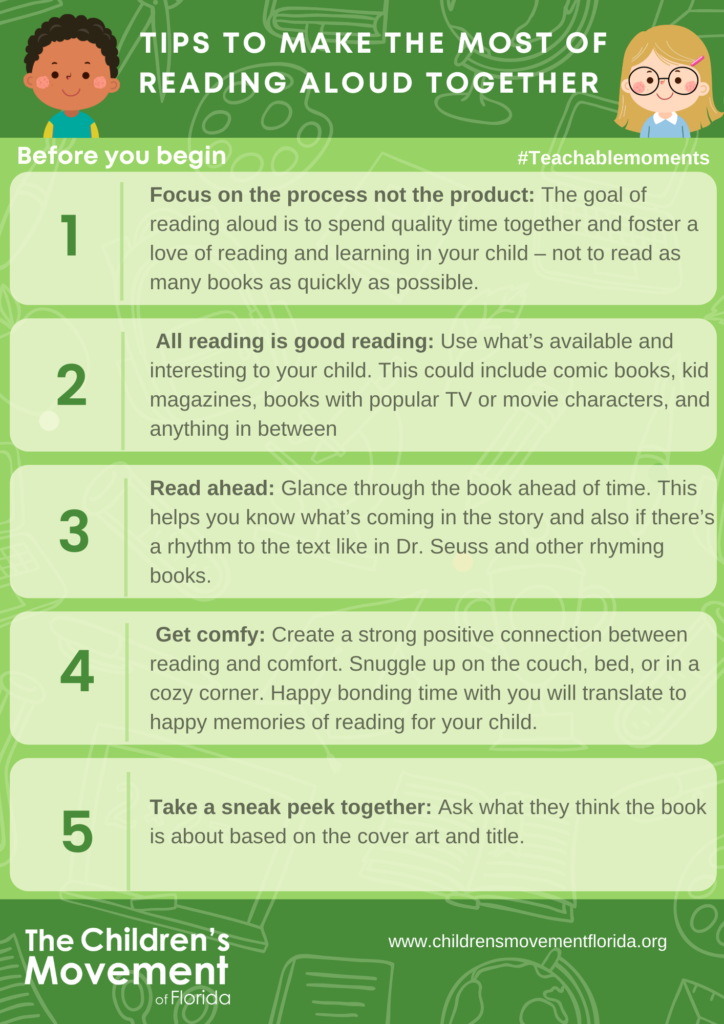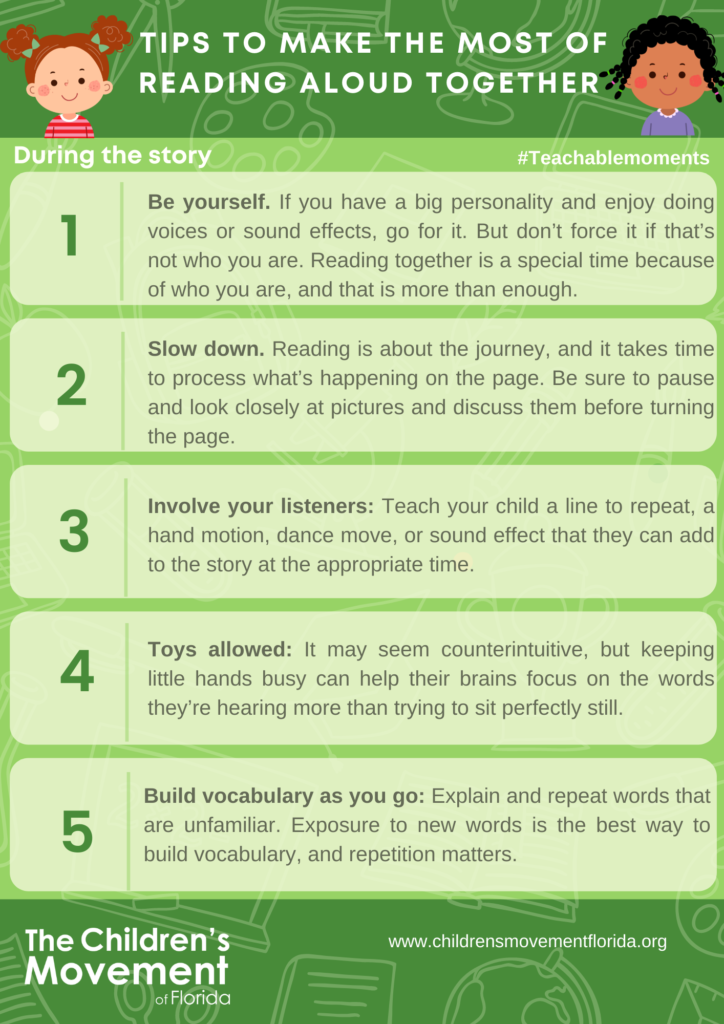
Reading aloud is the most important thing you can do to help your child learn to read. It’s not about choosing the “right” or even “challenging” books—all reading is good reading! Every book counts, and it’s essential you read together. This is true even when your child can already read on his own. Many children still love being read to right up through middle school.
Below are a few tips to make the most of reading with your children. Also, check out the #TeachableMoments graphics from The Children’s Movement of Florida at the bottom of this post for additional suggestions for before, during, and after reading together.
Take a sneak peek.
Before you begin reading, look at the cover of the book together. Talk to your child about what they think this book is about based on the cover art and title. Ask them what they think the characters might be like. If there are pictures of the main characters, ask your child to describe what they notice about them in terms of physical appearance (such as height, hair color, clothing) and personality traits (like if they seem friendly, curious, or funny).
Slow down.
I remember my father reading to me every night when I was a child. My dad slowed down when he read to me, giving me the time to think about what I was hearing and ask questions along the way. He never rushed through the words on the page, even though we had read these stories many times before.
When children are overwhelmed by words, they tune out and lose interest in what they are supposed to be learning. If we want children to enjoy reading together, we must slow down and give them time to absorb what they are hearing.
Involve your listeners.
Let your children know you care about what they think by asking questions about the book and encouraging them to share their thoughts. Ask them if they can predict what might happen next in the story and how they would feel if something happened to one of the characters or if a similar event occurred in their own lives. Encourage them to describe what they like and don’t like so far and why specific plot points are important to them.
Build vocabulary as you go.
To build vocabulary, ask your child questions about words in the story. What do they think a particular word means? When you give a definition, try explaining the meaning to them. This will help them remember new words and use them correctly.
Reading aloud is a great time to work on new vocabulary. This is especially easy if you reread books because you can add new language each time you return to a book. For example, when you read an animal-themed book for the first time, point out all the animal names as you go along (“Look at that cute kitten! And there’s a big dog!”). The next time you read the same book together, try expanding your language by adding descriptive words (“Oh no! The angry dog is chasing that fluffy white kitten!”). You can do this for any book with just about any theme.
You don’t have to finish a book.
If you can’t find a book everyone likes, scale back. Maybe it’s only one person who gets to choose for the night. If that doesn’t work, shorten reading time so that no one feels like it’s a chore—and don’t put any pressure on finishing the book.
We should encourage our children to take breaks from books they’re not enjoying—why waste precious reading time or turn them away from reading entirely? Instead, try out another story! No matter what happens with a particular book, and whether all or only one person enjoyed it, there is always something good about picking up a new book and reading it together.
Read a book again and again.
The more you read aloud, the more your child learns. Repetition helps kids learn, so it can be helpful to read a book repeatedly. Read it until your child knows the story by heart or even memorizes parts of it. If they can read a few words themselves, encourage them to chime in with the words they recognize.
Make reading part of your routine.
Set a reading time of day and stick to it. Like any new habit, making the most of reading aloud together requires commitment. It can be challenging at first, but you’ll soon see results and realize how much your child enjoys this quality time with you.
Bedtime is ideal for reading aloud because it’s often a more relaxed part of the day and provides an excellent opportunity to calm down before sleep. But if that doesn’t work in your family’s schedule, pick a different time together—maybe try after dinner or early in the morning before activities or school begins.
If possible, read aloud on weekends too! These special days are great for longer stories that won’t fit as well into the weeknight routine.
Four extra tips to make the most of read-aloud time:
- Read to your child every day, if possible.
- Read various books and genres to your young reader, including poetry, nursery rhymes, comics, fiction, and nonfiction.
- Choose authors from a variety of backgrounds to read aloud to your children.
- Read aloud in various settings: at home, at the library, and outdoors—perhaps in the backyard, on a picnic blanket under a tree, or while walking together.
Want to learn more? Check out these graphics from The Children’s Movement of Florida:


